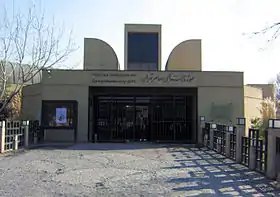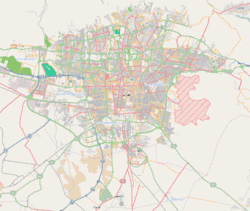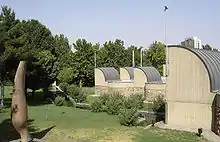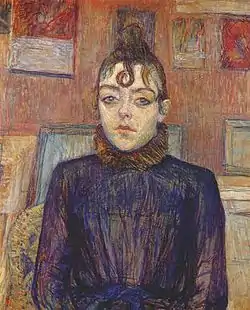Tehran Museum of Contemporary Art
Tehran Museum of Contemporary Art, (Persian: موزه هنرهای معاصر تهران), also known as TMoCA, is among the largest art museums in Tehran and Iran. It has collections of more than 3,000 items that include 19th and 20th century's world-class European and American paintings, prints, drawings and sculptures. TMoCA also has one of the greatest collections of Iranian modern and contemporary art.
موزه هنرهای معاصر تهران | |
 | |
 Location within Tehran | |
| Established | 1977 |
|---|---|
| Location | Laleh Park Tehran Iran |
| Coordinates | 35.7112°N 51.3904°E |
| Type | Art museum |
| Director | Ehsan Aghaei |
| Website | tmoca |

The museum was inaugurated by Empress Farah Pahlavi in 1977, just two years before the 1979 Revolution.[1] TMoCA is considered to have the most valuable collections of modern Western masterpieces outside Europe and North America.[2]
Background
According to Farah Pahlavi, the former Empress of Iran, the idea for this museum happened when she was in conversation with artist Iran Darroudi during a gallery opening in the 1970s and Darroudi mentioned she wished there was a place to show work more permanently.[3] The Tehran Museum of Contemporary Art museum was supposed to be a place to show contemporary and modern Iranian artist alongside other international artists doing similar work.[3]
The museum was designed by Iranian architect and cousin of the queen, Kamran Diba, who employed elements from traditional Persian architecture.[4] It was built adjacent to Laleh Park, Tehran, and was inaugurated in 1977.[5] The building itself can be regarded as an example of contemporary art, in a style of an underground New York Guggenheim Museum.[6] Most of the museum area is located underground with a circular walkway that spirals downwards with galleries branching outwards.[6] Western sculptures by artists such as Ernst, Giacometti, Magritte and Moore can be found in the museum's gardens.[6]
The selection of the art was done under Farah Pahlavi and the budget was from the National Iranian Oil Company.[3] Pahlavi personally met many of the artists whose work was part of the museum collection, including the Western artists Marc Chagall, Salvador Dalí, Henry Moore, Paul Jenkins, Arnaldo Pomodoro.[3] Some people involved in the process of selecting art were the Americans, Donna Stein and David Galloway, and Kamran Diba, the architect and director of the museum, and Karimpasha Bahadori, who was the chief of staff of the cabinet.[3]
After the Iranian Revolution in 1979, the Western art was stored away in the museums vault until 1999 when the first post-revolution exhibition was held of western art showing artists such as David Hockney, Roy Lichtenstein, Robert Rauschenberg and Andy Warhol.[6] Now pieces of the Western art collection are shown for a few weeks every year but due to the current conservative nature of the Iranian establishment, most pieces will never be shown.[6]
It is considered to have the most valuable collection of Western modern art outside Europe and the United States, a collection largely assembled by founding curators David Galloway and Donna Stein under the patronage of Farah Pahlavi.[7][8] It is said that there is approximately £2.5 billion worth of modern art held at the museum.[9] The museum hosts a revolving program of exhibitions and occasionally organizes exhibitions by local artists.
Politics
In 1977, the Empress of Iran, Farah Pahlavi, purchased expensive Western artwork, in order to open this contemporary art museum. This museum was a controversial act, because the country's social and economic inequalities were rising and the government at the time was acting as a dictatorship and not tolerating the rising opponents, a few years later the Iranian Revolution took place. A few art pieces did not survive the revolution including a public statue by Bahman Mohasses deemed un-Islamic and a 1977 Warhol painting, a portrait of Farah Pahlavi.[3]
Le Monde art critic André Fermigier wrote an article in 1977 called "A museum for whom and for what?", "questioning the link between an Iranian child and a Picasso or a Pollock".[10] And Farah Pahlavi responded to this criticism, noting that Iranians can understand modern art, not all Iranians were living in remote villages, and this issue with modern art was not unlike one that had existed in France.[10]
A touring exhibitions was planned for autumn 2016 in Berlin, (Germany), consisting of a three-month tour of sixty artworks, half Western and half Iranian. The show was to run for three months in Berlin, then travel to the Maxxi Museum of 21st Century Arts in Rome for display from March through August.[11] However, the plan has been indefinitely postponed because the Iranian authorities have failed to allow the paintings to leave the country, also noting after the revolution these painting have not yet been shown in Iran.[12][13]
Permanent collection

.jpg.webp)
This is a list of artists featured in the permanent collection at Tehran Museum of Contemporary Art.
- Paul Gauguin: Still Life with Head-Shaped Vase and Japanese Woodcut[14]
- Wassily Kandinsky
- Jackson Pollock: Mural on Indian Red Ground[15]
- Claude Monet
- Camille Pissarro
- Vincent van Gogh: At Eternity's Gate[16]
- Pierre-Auguste Renoir: Gabrielle with Open Blouse[17]
- James Ensor
- Édouard Vuillard
- André Dunoyer de Segonzac
- Jules Pascin
- André Derain: Golden Age[6]:54
- Louis Valtat
- Georges Rouault
- Fernand Léger
- Pablo Picasso: Baboon and Young, Painter and Model
- Alberto Giacometti: Standing Woman,[18] Walking Man 1[19]
- Francis Bacon: Two Figures Lying on a Bed With Attendants[6]:54
- Max Ernst: Capricorn[20]
- René Magritte: The Therapeutae[21]
- George Grosz
- John Hoyland
- Diego Rivera
- Jasper Johns
- Andy Warhol: Suicide (Purple Jumping Man),[22] portraits of Mick Jagger, Marilyn Monroe, and Mao Zedong[4]
- Roy Lichtenstein
- Jim Dine
- Peter Phillips
- James Rosenquist
- Fritz Winter
- Joan Miró
- Donald Judd
- Alexander Calder
- William Turnbull
- Victor Vasarely
- Adolph Gottlieb
- Richard Hamilton
- Georges Braque
- Jean-Paul Riopelle
- Edvard Munch
- Pierre Soulages
- Edgar Degas
- Mary Cassatt
- Maurice Prendergast
- František Kupka
- Max Beckmann
- James Whistler
- Edward Hopper
- Henry Moore: Two–Pieces Reclining Figure,[23] Three–Pieces Reclining Figure,[24] Oval with Points
- Giorgio Morandi
- Noreen Motamed
- Giacomo Balla
- Marcel Duchamp
- Noriyuki Haraguchi: Matter and Mind
- Ali Akbar Sadeghi: Myth & Math and Unwritten
- Marino Marini: Horse and Rider[25]
- Aydin Aghdashloo:[26] Identity: in praise of Sandro Botticelli and other works
- Parviz Tanavoli: Sanctified 1[27]
- Sterling Ruby
- Henry Peach Robinson: Landing the Catch
- Ansel Easton Adams: Canyon de Chelly
- Bahman Mohasses: Tryst
- Arnaldo Pomodoro
- Yaacov Agam: More than 10 oil and acrylic works[28]
- Manouchehr Yektai
- Sohrab Sepehri
- Abbas Kiarostami
See also
- International rankings of Iran
- Safir Office Machines Museum
- Modern and contemporary art in Iran
References
- Tehran Museum of Contemporary Art: The Crown Jewel, The Harpers Bazaar Arabia
- Iran Has Been Hiding One of the World’s Great Collections of Modern Art, Bloomberg
- Dehghan, Saeed Kamali (1 August 2012). "Former queen of Iran on assembling Tehran's art collection". the Guardian. Retrieved 16 June 2018.
- Dehghan, Saeed Kamali (1 August 2012). "Tehran exhibition reveals city's hidden Warhol and Hockney treasures". the Guardian. Retrieved 27 September 2015.
- Kaur, Raminder; Dave-Mukherji, Parul (2015). Arts and Aesthetics in a Globalizing World. Bloomsbury Publishing. p. 304. ISBN 9780857855473.
- Waldman, Peter; Motevalli, Golnar (23 November 2015). "The Greatest Museum Never Known". Bloomberg Businessweek. pp. 50–55.
- Dehghan, Saeed Kamali. "Former queen of Iran on assembling Tehran's art collection." The Guardian. 1 August 2012: Print.
- Iran Keeps Picassos in basement. LA Times. Kim Murphy. 19 September 2007.
- https://www.theguardian.com/world/2007/oct/29/artnews.iran
- Vassigh, Alidad. "Seeing Warhol in Tehran? The Saga of Iran's Modern Art Museum". Retrieved 26 March 2017.
- Nayeri, Farah (28 December 2016). "Berlin Cancels Rare Show of Modern Art from Tehran Museum". The New York Times. ISSN 0362-4331. Retrieved 26 March 2017.
- Dehghan, Kate Connolly Saeed Kamali (25 November 2016). "Iran pulls the plug on Tehran art exhibition in Berlin". The Guardian. ISSN 0261-3077. Retrieved 26 March 2017.
- Ayed, Nahlah; Jenzer, Stephanie (7 March 2017). "Why 99% of visiting foreign dignitaries ask to see inside a vault in Iran". CBC News. Retrieved 16 June 2018.
- "Paul Gauguin". Retrieved 6 October 2015.
- Olsen, Kelly (2 May 2012). "Jackson Pollock's Splashes of Paint From Iran". WSJ. Retrieved 27 September 2015.
- "At Eternity's Gate", vggallery.com. Last Retrieved 19 October 2011.
- Kim Murphy (19 September 2007). "Picasso is hiding in Iran". Los Angeles Times. Retrieved 28 September 2015.
- Alberto Giacometti, Standing Woman Archived 4 February 2013 at Archive.today, tmoca.com.
- Alberto Giacometti, Walking Man 1 Archived 16 October 2011 at the Wayback Machine, tmoca.com.
- Max Ernst, Capricorn Archived 16 October 2011 at the Wayback Machine, tmoca.com.
- René Magritte, The Therapeutae Archived 21 March 2011 at the Wayback Machine, tmoca.com.
- "Masterpiece Basement". The New York Times – Breaking News, World News & Multimedia. 2 December 2007. Retrieved 27 September 2015.
- Henry Moore, Two–Pieces Reclining Figure Archived 21 March 2011 at the Wayback Machine, tmoca.com.
- Henry Moore, Three–Pieces Reclining Figure Archived 21 March 2011 at the Wayback Machine, tmoca.com.
- "Archived copy". Archived from the original on 11 December 2014. Retrieved 10 December 2014.CS1 maint: archived copy as title (link)
- http://www.grafjo.ir/gonagon/295.html
- Parviz Tanavoli, Sanctified 1 Archived 16 October 2011 at the Wayback Machine, tmoca.com.
- Union, Ajax (5 August 2012). "Exclusive: Secret Iranian Art Collection Features Work from Iconic Israeli Artist Yaacov Agam". Algemeiner.com. Retrieved 6 October 2015.
External links
- Official website
 Media related to Tehran Museum of Contemporary Art at Wikimedia Commons
Media related to Tehran Museum of Contemporary Art at Wikimedia Commons

